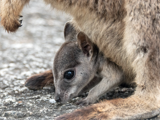If the animal is injured
-
Assess the Situation: Approach the bobtail lizard cautiously to assess its condition. Be mindful that the lizard may be frightened and may try to defend itself, so approach slowly and calmly to avoid causing further stress or injury.
-
Ensure Safety: If the bobtail lizard is in a dangerous location (e.g., near a road), safely move it to a quieter and safer area nearby. Use gloves or a towel to handle the lizard to protect yourself and avoid causing additional harm.
-
Containment: If possible, gently place the injured bobtail lizard into a ventilated container such as a cardboard box or a plastic container with air holes. Line the container with a soft cloth or paper towel to provide comfort and prevent the lizard from sliding around.
-
Keep Warm and Quiet: Keep the bobtail lizard in a quiet, dark place away from pets, children, and noise. Use a heating pad set on low or a warm water bottle wrapped in a towel (to avoid direct contact) to help maintain its body temperature, especially if it's cold outside.
-
Seek Professional Help: Contact a local wildlife rescue organisation such as our team here at Kanyana Wildlife. These professionals have the expertise and resources to provide appropriate care and treatment for the injured bobtail lizard.
-
Do Not Offer Food or Water: Refrain from feeding or giving water to the injured lizard. Allow trained wildlife carers to assess its condition and provide suitable care.
-
Follow Advice: Follow any advice or instructions given by the wildlife rescue organization or rehabilitator. They may provide guidance on transporting the lizard to them or offer initial care instructions if immediate help is not readily available.
If the animal is dead
-
Handle with Care: Use gloves or a plastic bag to handle the lizard to minimize direct contact. This helps protect you from any potential diseases or parasites the lizard might carry.
-
Dispose Properly: Place the dead bobtail lizard in a sealed plastic bag and then dispose of it in your household waste bin. Do not bury it or leave it exposed, as this could attract scavengers or spread disease.
-
Report to Authorities (Optional): While it's not usually necessary to report a dead bobtail lizard, if you notice multiple dead lizards in the area or suspect there may be a larger issue (such as poisoning or disease outbreak), you can contact your local wildlife rescue organization or state wildlife agency for advice.
-
Personal Hygiene: After handling the lizard or disposing of it, wash your hands thoroughly with soap and water to reduce the risk of any potential contamination.
-
Observe for Other Wildlife: Keep an eye out for other sick or injured wildlife in the area. If you notice a pattern of deaths among wildlife, especially if it seems unusual or widespread, reporting it to authorities may be important for investigation and conservation efforts.

Be a Wildlife Hero
Make a difference today by supporting Kanyana Wildlife.
Join us in safeguarding Australia's precious wildlife through rescue, rehabilitation, and habitat protection.
Your support powers our mission and your generosity directly impacts the lives of injured, orphaned, and displaced animals in need. Together, we can make a lasting impact on wildlife conservation right here in Western Australia.
Whether you donate, volunteer, or adopt, you're making a difference.

